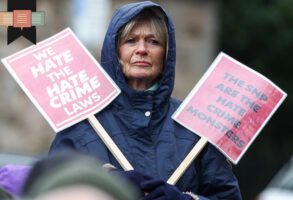Published December 21, 2013
In the new book Roman Pilgrimage, written with Elizabeth Lev and Stephen Weigel, George Weigel, biographer of Pope John Paul II — who is to be canonized this April — opens with a quote from the late pontiff: “To go in a spirit of prayer from one place to another . . . helps us not only live our lives as a journey, but also gives us a vivid sense of a God who has gone before us and leads us on, who himself set out on man’s path, a God who does not look down on us from on high, but who has become our traveling companion.”
Weigel, distinguished senior fellow at the Ethics and Public Policy Center, talks about the Station Churches of Rome — a pilgrimage that has had a recent revival — with National Review Online’s Kathryn Jean Lopez.
KATHRYN JEAN LOPEZ: What is so important about the concept of a pilgrimage, and why have people “in virtually every time and place known to history” embarked on them?
GEORGE WEIGEL: There seems to be something about pilgrimage hard-wired into homo religiosus. In biblical religion, of course, that instinct to go from one place to another in a spirit of prayer is aroused by the central fact of revelation. Faith in the God of the Bible is not a matter of our search for God, but God’s search for us — God coming into history (first in the people of Israel, then in the Church) and asking us to follow the same path through history that He is taking. That understanding of God-in-history and us-in-history is also one of the central contributions of Biblical religion to Western Civilization: the idea that life is not just one damn thing after another, or a great and repetitive cycle, but an adventure, a journey, a pilgrimage with a starting point and a destination. And as I point out in Roman Pilgrimage, the station-church pilgrimage reminds us that the end of the journey is the wedding feast of the Lamb in the New Jerusalem. Not a bad destination, that.
LOPEZ: Is this book just for Catholics? What’s in it that is of interest to everyone?
WEIGEL: No one does the art and architecture of Rome better than Liz Lev, and her commentaries on the station churches are masterpieces of the art historian’s and art guide’s craft. I’ll risk a charge of special pleading and say that very few people have photographed these sites, the familiar ones and the unfamiliar ones, as well as my son, Stephen (you really get a sense of the quality of his work in the eBook version of Roman Pilgrimage, where all the photographs are in color, and can be zoomed in to a remarkable degree of resolution). Then there’s the history of the churches, and indeed the cultural history of Rome, both of which one meets along the station-church path. Several of my evangelical Protestant friends have told me that they’ve appreciated my commentaries on the Biblical texts of Lent, and those texts, plus the patristic texts on which I comment, are surely not for Catholics only.
LOPEZ: How is the station-church pilgrimage “an itinerary of conversion”?
WEIGEL: Conversion is not a one-off deal in the spiritual life; conversion, deeper conversion, is a lifelong process of practicing the presence of God and the imitation of Christ. The station-church pilgrimage is an opportunity to enter into that process of purification and spiritual strengthening in a unique way that touches the heart, the mind, and the senses as well as the soul.
LOPEZ: It’s a pilgrimage steeped in history. How was it that some English-speaking seminarians revived it?
WEIGEL: The station-church pilgrimage evolved in the middle centuries of the first millennium as the ordinary way the pope celebrated Mass with the people of Rome during Lent. The practice atrophied over time, especially after the papacy’s exile in Avignon, but its memory remained in the liturgy of the Church, where the “station” of the day was listed in every Roman Missal until the new missal of Paul VI in 1969. In the mid 1970s, American seminarians and student priests began walking to the daily station church in Rome during Lent, and from that modest beginning (in which major Church leaders like the current archbishop for the military services, Timothy Broglio, were involved) has come today’s experience of the station-church pilgrimage, which is led by the North American College (the American national seminary in Rome) and involves hundreds of Anglophones living, studying, and working in Rome. Thus an ancient Roman tradition has been resurrected in 21st-century guise by the church of the New World — another sign of the vitality of the Church in the United States.
LOPEZ: Why have the tombs of the martyrs long been a meeting place for Christians?
WEIGEL: Veneration of the martyrs is as ancient as the Acts of the Apostles. In Rome, martyrs’ homes often became house churches, which evolved into basilicas, which were then transformed architecturally and aesthetically over the centuries, as Liz describes in our book.
LOPEZ: Knowing that, in times of persecution, Christians in Rome would head to the tombs of the martyrs, are we in solidarity with the Christians today who face the threat of martyrdom when we pray at these spots?
WEIGEL: To be sure. Indeed, during the station-church pilgrimage of 2011, which Liz, Stephen, and I made in full, the general intercessions at every Mass included prayers for the persecuted Church throughout the world, especially in the Middle East.
LOPEZ: Who are the martyrs “nunc” the book is dedicated to?
WEIGEL: Men like Shahbaz Bhatti, the Pakistani martyr who will, I am confident, be canonized some day. Men the Chinese Communist regime would just as soon have the Church forget, like Bishop Francis Ford of Maryknoll, martyred by the Maoists. The men and women who put their lives at risk by professing Christ every day in North Africa, sub-Saharan Africa, the Levant, Pakistan, and the house churches of China.
LOPEZ: Can stones be “witnesses,” and what can they tell someone in 2014?
WEIGEL: The sanctity of holy places like the station churches comes not so much from the stones as from the prayers and witness of those who have prayed in these sites for centuries. Yet there is something splendidly tactile about the station-church pilgrimage, during which one encounters the chains that bound Peter and Paul in their imprisonments, bits of the gridiron on which St. Lawrence was martyred, the pillar of flagellation from the Passion, and so forth. All these things remind us that Christianity is not a “narrative”; Christian truth is firmly tethered to history, to times we can know and places we can still touch.
LOPEZ: Why Mass? How important is the Eucharist to this pilgrimage?
WEIGEL: Absolutely central, for in the daily celebration of Holy Mass during the pilgrimage, the Eucharist is literally viaticum, “food for the journey” — not just at the hour of death, but for the journey throughout daily life.
LOPEZ: How would this pilgrimage make a difference in the observing and fasting of Lent?
WEIGEL: It makes a lot of difference, and you don’t have to be in Rome to do it (which is the whole idea of the book), although if you do make the pilgrimage in Rome, or at least a part of the pilgrimage, it’s a marvelous way to learn the city, early in the morning before the cacophony begins. But “doing Rome at home” through Roman Pilgrimage also makes a difference, in that it allows readers to become vicarious pilgrims who are taking the time and making the effort to dig a little more deeply, each day, into the Bible and some of the greatest of early Christian literature in the texts that form the literary backbone of the liturgy of each day.
LOPEZ: Pope Francis held what are believed to be the bones of St. Peter in his arms during the creed at the recent closing Mass of the Year of Faith Pope Benedict instituted last fall. What was the significance of that action?
WEIGEL: It illustrated what I said a moment ago: that Christianity begins with real things happening to real people, in real places and at times we can know with real historical certainty. How did a Galilean fisherman, probably illiterate, from east of nowhere, get to the center of world power and, after being butchered to amuse the mob, eventually get himself the world’s greatest tombstone (which we know as the Patriarchal Vatican Basilica of St. Peter’s)? That’s the question the relics and the basilica demand be confronted: How did that happen? And the answer, which is central to Pope Francis’s insistence on evangelical Catholicism, is that that day laborer from the shores of the Sea of Galilee became a friend of the rabbi Jesus from Nazareth, whom he eventually came to know as the risen Lord Jesus Christ — and that knowing led him and others to convert the world.
LOPEZ: Your reflections in Roman Pilgrimage cite the Liturgy of the Hours often. How important is that prayer to the life of the Church? Would it help the “evangelical Catholic” effort if more lay people prayed it in the Church?
WEIGEL: The Church has long believed that the entire day should be sanctified by prayer, in a daily rhythm of praise, repentance, supplication, and thanksgiving. The monthly prayerbook Magnificat helps busy people do this in a modified, simplified, and yet serious way. But the Liturgy of the Hours is the prayer of the whole Church, not just the prayer of clerics and consecrated religious who are bound to pray it by canon law or vows. I’ve been praying it for almost thirty years and have found the Divine Office a bottomless ocean of inspiration. So yes, Evangelical Catholicism is certainly advanced by a more widespread use of the Liturgy of the Hours in the Church.
LOPEZ: There is an examination of conscience that happens and deepens along the Roman pilgrimage route. How important is examination of conscience beyond Lent and beyond Rome — perhaps in understanding conscience and religious liberty as a matter of law and policy and politics?
WEIGEL: The forty days (and beyond) in which the station-church pilgrimage unfolds offer us a chance to look into our hearts to see what is in there that is impeding our mission as disciples called to bring friendship with Christ to others, which is another way of asking ourselves the question: How well am I imitating Christ the Lord in my own life? One of the important things about the texts of the station-church pilgrimage, though, is that they tether this introspection to the Bible and the Fathers of the Church, so that examinations of conscience don’t lapse into subjectivism, which can often be the road to self-indulgence and self-justification. And of course the examination of conscience to which the pilgrimage invites us involves looking into our lives as citizens, which cannot be divorced from our lives as disciples. I would also hope that a daily meditation on the martyrs, which is inevitable in making the station-church pilgrimage in Rome or at home, is a reminder of the centrality of religious freedom to any meaningful scheme of human rights, and a fundamental building block of the just society.
LOPEZ: You’ve just returned from Rome. Is it a different kind of place under Papa Francesco?
WEIGEL: Wednesdays around St. Peter’s Square are certainly a bit more hectic. The pontificate is still in its early days. But the pope has grabbed the world’s attention, and that creates a very real evangelical opportunity. It would be a shame if that opportunity were squandered by Catholic internecine sniping — or by politicians and media personalities instrumentalizing the pope.
LOPEZ: What is this “Francis effect” people keep talking about? Are people on the left too gleeful and those on the right too worried?
WEIGEL: If Pope Francis has given people an inkling of the power of the Divine Mercy at work in a life, then I hope that will invite people to encounter Christ in his fullness, which includes his teaching of the truth as well as his merciful forgiveness when we fail to live the truth, as we all do. As for the pope and the blogosphere battles, there’s too much work to do converting a post-Christian culture to fret very much about that.
LOPEZ: Do you have any idea how many times you’ve been to Rome? Are there new discoveries for you still there? Any recent ones?
WEIGEL: I could mention new restaurants, but that might make me appear sybaritic, which would never do. I have no idea how many times I’ve been to Rome; it’s now one of the places I work, albeit in one-or-two-week periods (or six-and-a-half weeks, as this past February and March). But as for new things, sure; the city is inexhaustible, historically and aesthetically — and even in Catholic terms. Just this past Tuesday morning I attended Mass in one of the chapels I had never seen before, down in the Vatican grottoes, with my friends Msgr. Thomas Powers and Father Leo Patalinghug. The chapel had an exquisite, antique fresco of the Madonna and Child and some of the finest Cosmatesque decoration I’ve ever seen. Dr. Johnson’s observation that getting tired of London means getting tired of life applies to Rome, too.
LOPEZ: As we are about to celebrate the mystery of the Incarnation at Christmas, how should we bear Christ’s passion, death, and resurrection in mind?
WEIGEL: The Paschal mystery of Christ’s passion, death, and resurrection makes Christmas make sense. Christmas without Good Friday and Easter is mere sentimentality. Christmas read through the prism of the cross and resurrection is the celebration of the truth that Paul confesses to Titus in the second reading at midnight Mass on Christmas: “The grace of God has appeared.”
— Kathryn Jean Lopez is editor-at-large of National Review Online.






